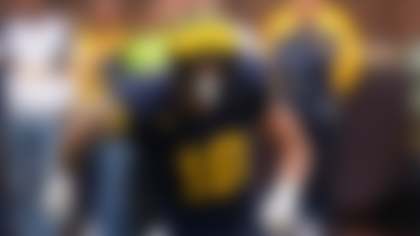It's "'60s Week" at NFL Network!
Yes, throughout the month of June, we're celebrating different decades of the league's history. Of course, these decades don't just represent 10-year periods, but rather benchmarks in the development of America's game.
Harrison: 32 franchises, 32 icons
Who is the greatest player of all time for each NFL organization? Elliot Harrison tackles this challenging question. **READ**
With that in mind, I've listed below what I consider to be five major NFL turning points that occurred in the 1960s. Of course, they weren't all immediately viewed as obvious touchstone moments -- it took time for the true breadth of their impact to be revealed, as is often the case with transcendent developments. But it would be impossible to imagine our game without the butterfly effect of each of these five seemingly innocuous occurrences.
As always, feel free to share your thoughts: @HarrisonNFL is the place.
Now, let's start with the first year of the decade, which marked the end of the Eisenhower era -- and an era of mediocrity for the franchise in Philly ...
Norm Van Brocklin delivers a title to Philadelphia
While today's NFL teams aim to develop a franchise quarterback from within, the allure of going out and acquiring a veteran signal-caller still exists. In a win-now league, teams of a certain makeup routinely turn to the established QB who -- theoretically -- can deliver the goods immediately. The Denver Broncos won the Peyton Manning sweepstakes in 2012, and they've received a pretty nice return on that investment. The Arizona Cardinals rode Kurt Warner to Super Bowl XLIII. Meanwhile, the Washington Redskins and Minnesota Vikings both dabbled in the Donovan McNabb experience, with neither team coming away happy.
So what does all of this stem from? What made clubs realize that real success revolves around the quarterback position?
One (right) answer would be the Philadelphia Eagles' acquisition of Norm Van Brocklin. The 30-something came over from the Los Angeles Rams via trade in 1958. With a reputation for being immensely talented and a bit surly, Van Brocklin also possessed one key characteristic for the position: an extremely high football IQ. At a time when running backs and middle linebackers often were considered more important than quarterbacks, Van Brocklin showed the football world that notion was a bunch of bologna.
After failing to eclipse seven wins in any season during the entire decade of the 1950s, the Eagles shocked everyone in 1960. With Van Brocklin putting the club on his back, Philadelphia rampaged to a 10-2 regular-season record before upending Vince Lombardi's Green Bay Packers in the NFL Championship Game. Prior to Philly's Van Brocklin-led run, no NFL team had ever won a title with a QB who previously had logged more than seven seasons with another team.
Wouldn't you know it, the very next year, the New York Giants acquired 34-year-old Y.A. Tittle in a trade with the San Francisco 49ers, hoping to follow in the Eagles' footsteps. Tittle proceeded to guide the G-Men to three straight championship games, but they ended up bridesmaids in each.
"The Flying Dutchman," as Van Brocklin was called, is also remembered for one other little footnote of NFL history: racking up 554 passing yards in a single game -- still the record, more than six decades later.
Sid Gillman's Chargers deep-six the Patriots
Some championship blowouts are hardly entertaining and barely memorable, like the Dallas Cowboys' back-to-backboat racings of the Buffalo Bills in the mid-1990s or the Seattle Seahawks' Lombardi romp this past February. And then there are those that matter. The San Diego Chargers' 51-10 demolition of the Boston Patriots in the 1963 AFL title game qualifies.
Coach Sid Gillman's Bolts showed the AFL -- and those in the NFL who realized the rival league was here to stay -- that "3 yards and a cloud of dust" was not the way to do things anymore. San Diego tossed up 610 yards of total offense with the original "West Coast" offense, a vertical attack that used aerial acrobatics to set up an also-potent ground game. In the 41-point victory over Boston, San Diego's two quarterbacks -- Tobin Rote, a vet acquired from another team (wink, wink), and John Hadl -- each averaged over 11 yards per throw, while Keith Lincoln ran for 206 yards on just 13 attempts.
Much of Don Coryell's ideas (i.e., "Air Coryell") and the very offense those '90s Cowboys employed came from Gillman's scheme. So did Al Davis' love of the deep ball. Even iconic 49ers coach Bill Walsh was influenced by Gillman's philosophies during Walsh's time as a Raiders assistant (under Davis), though Walsh obviously put his own signature on things. (Walsh, of course, become known for the short passing game, and for viewing passes to his backs as an extension of the handoff. In a related note: Lincoln, a running back, had 123 yards receiving in the 1963 AFL title game.)
Coryell, Davis and Walsh -- three legends who certainly took notice of Gillman's offense. Not a bad legacy to have.
1-for-15
Following the 1965 season, the NFL and AFL were in an all-out war. Bidding for college players was torpedoing organizational profits (see: Joe Namath's contract). The NFL had long fought Major League Baseball, college football and boxing for America's attention ... only to watch painfully as the AFL cannibalized that hard-earned spotlight.
And then came Timberlake -- and not the good kind.
You might not have heard of Bob Timberlake, but the pride of the University of Michigan had himself about the worst season a kicker could have in 1965. A third-round pick by the New York Giants that year, Timberlake made one -- one -- of his 15 field-goal attempts. And it was because of that horrific performance that, in 1966, Giants owner Wellington Mara signed Pete Gogolak, whose deal was up with the Buffalo Bills of the rival AFL.
Wrong move.
Bidding on draft picks was one thing; signing the other league's players was another. Bear in mind, there was no free agency in the spring of '66 -- when a player's contract ran out, his organization had first right of re-signing. In effect, Mara unilaterally raided a player from an AFL team, which was really the last straw in the cold war between the two leagues.
Upon hearing the news of Mara's move, both AFL and NFL owners shrieked. Mara's friend, Vince Lombardi, deemed it "stupid." Al Davis wanted full-scale war and set out to sign star quarterback Roman Gabriel of the NFL's Los Angeles Rams. Meanwhile, the NFL's brain trust knew the Gogolak signing established a dangerous precedent that could drive player salaries to the moon.
Twenty-two days after Mara signed Gogolak, on the evening of June 8, 1966, owners on both sides and NFL Commissioner Pete Rozelle came to an understanding that there would be peace between the two leagues, as well as no further raiding of players. They announced a merger at the Warwick Hotel in New York City that called for a common draft, a championship game between the two leagues (later dubbed the Super Bowl) and a new joint league to begin in 1970.
Amazing. The futility of one kicker led to the signing of another, setting off a series of events that eventually sealed the formation of the modern NFL.
The world's fastest human blows through Washington
In the mid-1960s, league observers were watching pro football change without even knowing it. Some saw an inevitable AFL-NFL merger on the horizon. Others saw changes in the athletes themselves, as players from historically black colleges were beginning to make their mark on the game.
Bob Hayes, the Florida A&M product who was dubbed "the world's fastest human" after winning gold in the 100 meters at the 1964 Olympics, put up mean numbers as a rookie in 1965 (46 catches for 1,003 yards and 12 touchdowns). But, of course, an NFL player has to do it for more than a year before the purists take note (especially in the days before Al Gore invented the Internet). Yet, by mid-1966, opposing teams were forced to cast full game-planning attention on Hayes, who hadn't slowed down a bit. After No. 22 blew through the Washington Redskins with nine catches for 246 yards and two touchdowns at District of Columbia Stadium, rival coaches and players knew this track star was also a football star, and they had to do something to contain him.
"Bullet" Bob Hayes, meet the zone. Hayes' reputation and monster day in Washington -- in a Don Meredith-Sonny Jurgensen shootout for the ages -- served notice that defenses couldn't strictly go man-to-man. Coaches started putting safeties over the top, no longer asking their corners to exclusively live on an island. Well, at least against explosive guys like Hayes. It seems unreal now that one dude could be responsible for the development of the zone defense, but that notion is not too distant from the truth. Hayes was flat-out killing teams. Can you imagine the NFL without the Cover 2 or prevent?
Dave Robinson's minus-2
Whenever we see NFL Films footage of the 1960s, it usually has something to do with Lombardi's Packers. And why not? During that decade, the greatest coach of all time won five NFL championships and the first two Super Bowls. Shoot, the winning trophy bears Lombardi's name because of those wins in Super Bowls I and II. Yet, had it not been for Hall of Fame linebacker Dave Robinson's gamble, we just might be calling that silver thing "The Landry Trophy," after legendary Cowboys coach Tom Landry.
Dallas had itself a heckuva squad in 1966. The Cowboys went 10-3-1 en route to meeting the Packers at the Cotton Bowl in the NFL title game, with the winner earning the right to go to Super Bowl I. It was an incredible game marked by big scoring plays and turnovers, and ultimately, a contest that went down to the wire.
Down 34-27 late, the Cowboys encountered a second-and-goal at the 2-yard line. On the ensuing play, Dallas false started, but crowd noise drowned out the whistle. As the players continued to compete, Don Meredith found a wide-open Pettis Norman in the end zone ... and the tight end dropped the ball. Given the flag, the play shouldn't have mattered at all anyway. ... Ah, but it did.
After the penalty, the Cowboys worked their way back to the 2-yard line over the next two plays, setting up a do-or-die fourth-and-goal. Green Bay called roughly the same defense as it employed on the ill-fated false-start play that had resulted in Norman being wide open. On that initial play, Robinson had stayed in to contain -- it's what he was coached to do -- which left him watching helplessly as Meredith found his man in the end zone. On fourth down, though, Robinson said to hell with that and decided to take a risk, bearing in on Meredith so quickly that the Dallas quarterback could barely release the ball before the big linebacker was on him. Meredith's pass was a duck, fluttering harmlessly into the hands of Packers safety Tom Brown.
Had they tied the game, the Cowboys would have had a good shot to win in overtime, being at home and having secured momentum. They were also a better team than the Kansas City Chiefs club Green Bay went on to beat in Super Bowl I. And if the 'Boys had taken home the hardware that season, they certainly would have had the confidence to beat the Packers in the "Ice Bowl" the following season, potentially setting up a second straight Super Bowl win.
"I'll tell you, the Cowboys would have beaten both the Kansas City Chiefs and the Oakland Raiders (in Super Bowl II). That's my humble opinion," Robinson once told The Dallas Morning News. "If they had gotten past the Packers, I think it would be the Landry Trophy."
Robinson's reward for his good work? A minus-2 grade from Lombardi -- for not carrying out his original assignment on the play.
Follow Elliot Harrison on Twitter @HarrisonNFL.












